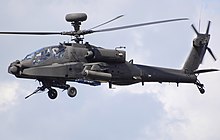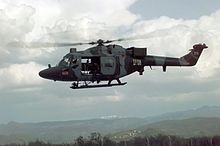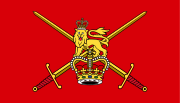Army Air Corps (United Kingdom)
| Army Air Corps | |
|---|---|
| File:MAF0025.jpg Cap Badge of the Army Air Corps | |
| Active | 1942–1949 1957 – present |
| Country | |
| Branch | British Army |
| Type | Army aviation branch |
| Role | Battlefield support and reconnaissance |
| Size | 202 aircraft |
| Garrison/HQ | 1 Regiment: Gütersloh, Germany 2 Regiment: Middle Wallop 3 Regiment: Wattisham 4 Regiment: Wattisham 5 Regiment: RAF Aldergrove 6 Regiment: TA Reserve 7 Regiment: Middle Wallop 9 Regiment: Dishforth |
| March | Quick: Recce Flight Slow: Thievish Magpie |
| Battle honours | Falkland Islands 1982, Wadi al Batin, Gulf 1991, Al-Basrah, Iraq 2003 |
| Commanders | |
| Colonel-in-Chief | HRH The Prince of Wales |
| Colonel of the Regiment | General The Rt Hon. The Lord Dannatt KCB CBE MC |
| Insignia | |
| Roundels |  |
| Aircraft flown | |
| Attack | Apache AH1 |
| Patrol | Lynx |
| Reconnaissance | Gazelle AH1, Islander AL1 |
| Trainer | Eurocopter Squirrel AS350BB, Grob Tutor |
| Transport | Bell 212HP, Lynx, Agusta A109A, Islander AL1 |
The Army Air Corps is a component of the British Army, first formed in 1942. There are eight regiments (5 Regular Army, 2 Territorial Army, 1 training) of the AAC as well as five Independent Flights and two Independent Squadrons deployed in support of British Army operations across the world. They are located in Britain, Belize, Brunei, Canada, and Germany. The AAC provides the offensive air elements of 16th Air Assault Brigade.
History of the AAC
The first Army Air Corps
The British Army first took to the sky during the 19th century with the use of observation balloons.[1] In 1911 the Air Battalion of the Royal Engineers was the first heavier-than-air British military aviation unit.[2] The following year, the Battalion was expanded into the Military Wing of the Royal Flying Corps which saw action throughout most of the First World War until 1 April 1918, when it was merged with the Royal Naval Air Service to form the Royal Air Force.[3]
Between the wars, the Army used RAF co-operation squadrons,[4] though a true army presence did not occur until the Second World War.
At the beginning of the Second World War, Royal Artillery officers, with the assistance of RAF technicians, flew Auster observation aircraft under RAF-owned Air Observation Post (AOP) Squadrons. Twelve such squadrons were raised[5][6][7] —three of which belonged to the RCAF— and each performed vital duties in a wide array of missions in many theatres.
Early in the war, Winston Churchill, Prime Minister of the United Kingdom, announced the establishment of a new branch of army aviation, the Army Air Corps, formed in 1942. The corps initially comprised the Glider Pilot Regiment and the Parachute Battalions (subsequently the Parachute Regiment), and the Air Observation Post Squadrons. In 1944, the SAS Regiment was added to the Corps.
One of their most successful exploits during the war was Operation Deadstick the attack on Pegasus Bridge, which occurred on 6 June 1944, prior to the landings on Normandy. Once the three gliders landed, some roughly which incurred casualties, the pilots joined the glider-borne troops (Ox's & Bucks Light Infantry) to act as infantry. The Bridge was taken within ten minutes of the battle commencing and the men there withstood numerous attempts by the Germans to re-capture the location. They were soon reinforced and relieved by soldiers from Lord Lovat's 1 Special Service Brigade, famously led by piper Bill Millin. It was subsequently further reinforced by units of the British 3rd Division.
The AAC was broken up in 1949, with the SAS returning to its independent status, while the Parachute Regiment and Glider Pilot Regiment came under the umbrella of the Glider Pilot and Parachute Corps. The pilots who had once flown the gliders soon had to transfer to flying powered aircraft, becoming part of the RAF Air Observation Post (AOP) Squadrons, several of which were manned by reserve personnel.
The present Army Air Corps

In 1957 the Glider Pilot and Parachute Corps was renamed to The Parachute Regiment, while the Glider Pilot Regiment and the Air Observation Squadrons amalgamated into a new unit, the Army Air Corps.[8]
From 1970, nearly every army brigade had at least one Aviation Squadron that usually numbered twelve aircraft. The main rotor aircraft during the 1970s were the Westland Scout and Bell Sioux general purpose helicopters. Their power though was soon bolstered by the introduction of the Westland Lynx helicopter in 1977 as well as the unarmed Westland Gazelle.
Basic rotary flying training was carried out on the Bell Sioux in the 1970s, the Westland Gazelle in the 1980s and 1990s and is currently conducted on the Eurocopter AS350 Squirrel.
Fixed-wing types in AAC service have included the Auster AOP.6 and AOP.9 and DHC-2 Beaver AL.1 in the observation and liaison roles. Since 1989, the AAC have operated a number of Britten-Norman Islander and Defender aircraft for surveillance and light transport duties. The corps operated the DHC-1 Chipmunk T.10 in the training role until its replacement by the Slingsby T-67 Firefly in the 1990s. The Slingsby T-67 Firefly was replaced by the Grob Tutor in 2010.
A further boost in the Army Air Corps' capability came in the form of the Westland Apache AH.1 attack helicopter. In 2006, British Apaches deployed to Afghanistan as part of the NATO International Security Assistance Force.
Aircraft of the AAC

- Britten-Norman Islander AL1[10]
- Britten-Norman Defender AL1/AL2/T3
- Eurocopter AS365N3 Dauphin[11]
- Eurocopter Squirrel HT2[12]
- Grob Tutor (at Army Flying Grading & DEFTS)
- Westland Gazelle AH1[13]


Structure
 |
| Arms of the British Army |
|---|
| Combat Arms |
| Combat Support Arms |
| Combat Services |
|
|
Regiments
- 1 Regiment, Army Air Corps[16] (organic to 1st Armoured Division)
- 652 Squadron (until September 1957 No. 652 Squadron RAF)
- 661 Squadron (until March 1957 No. 661 Squadron RAF)
- 2 (Training) Regiment, Army Air Corps
- 668 (Training) Squadron (until November 1945 No. 668 Squadron RAF)
- 676 (Training) Squadron
- 3 Regiment, Army Air Corps
- 653 Squadron (until September 1945 No. 653 Squadron RAF)
- 662 Squadron (until March 1957 No. 662 Squadron RAF)
- 663 Squadron (until March 1957 No. 663 Squadron RAF)
- 4 Regiment, Army Air Corps
- 654 Squadron (until June 1947 No. 654 Squadron RAF)
- 656 Squadron (until September 1957 No. 656 Squadron RAF)
- 664 Squadron (until March 1957 No. 664 Squadron RAF)
- 5 Regiment, Army Air Corps
- 651 Squadron (until September 1957 No. 651 Squadron RAF)
- 665 Squadron (until July 1945 No. 665 Squadron RCAF)
- 6 (Volunteer) Regiment, Army Air Corps
- 677 Squadron (Suffolk and Norfolk Yeomanry)
- 655 Squadron (V) The Scottish Horse a sub unit based at Middle Wallop
- 7 (Training) Regiment, Army Air Corps
- 670 (Training) Squadron (until July 1946 No. 670 Squadron RAF)
- 671 (Training) Squadron (until July 1946 No. 671 Squadron RAF)
- 673 (AH Training) Squadron (until October 1945 No. 673 Squadron RAF)
- 9 Regiment, Army Air Corps
- 659 Squadron (until August 1947 No. 659 Squadron RAF)
- 669 Squadron (until November 1945 No. 669 Squadron RAF)
- 672 Squadron (until July 1946 No. 672 Squadron RAF)
Independent units
- Independent flights
- 7 Flight Army Air Corps (Brunei)
- 8 Flight Army Air Corps (Credenhill, United Kingdom)
- 25 Flight Army Air Corps (Middle Wallop)
- 29 (BATUS) Flight Army Air Corps (Alberta, Canada)
- Independent squadrons
Other units
- 660 Squadron AAC (Defence Helicopter Flying School)
- 667 Squadron AAC (Development and Trials)
- 674 Squadron AAC (Defence Elementary Flying Training School)
- The Band Of The Army Air Corps
- Army Flying Grading
- Army Air Corps Historic Aircraft Flight
- The Army Air Corps Blue Eagles Display Team
- The Army Air Corps Parachute Display Team
Former units
The flight's base at Dhekelia has been closed for sometime and the Flight are no longer listed on the AAC Website as an active flight.[17]
The UNFICYP Flight Army Air Corps, originally known as the Force Aviation Flight, became, operational on 27 March 1964.The Flight was originally equipped with Alouette II helicopters. Duties ended 30th September 1994 when the Flight was replaced by a flight from the Argentine Air Force, ending thirty years, six months and four days of service under the UN flag. [18]
- 2 Flight Army Air Corps (Netheravon, United Kingdom) (assigned to ACE Mobile Force (Land))
- 20 Independent Reconnaissance Flight (RAF Shatin) (Hong Kong)
Former aircraft of the AAC
- Agusta A109A
- Agusta-Bell Sioux AH1
- Auster AOP9
- de Havilland Canada Chipmunk T10
- de Havilland Canada Beaver AL1
- Sud Alouette AH2
- Westland Scout AH1
- DHC-1 Chipmunk T.10
- Slingsby T.67M Firefly 160 (at Army Flying Grading)
- Slingsby T.67M Firefly 260 (at DEFTS)
Historic aircraft flight

- Agusta-Bell Sioux AH1
- Auster AOP9
- de Havilland Canada Chipmunk T10
- de Havilland Canada Beaver AL1
- Sud Alouette AH2
- Westland Scout AH1
Battle honours
The Army Air Corps is classed, in UK military parlance, as a "Combat Arm". It therefore carries its own guidon and is awarded battle honours. The honours awarded to the AAC are:
- Normandy Landings 1944
- Merville Battery 1944
- Rhine 1945
- North West Europe 1944 - 45
- Sicily 1943
- Pegasus Bridge
- Arnhem 1944
- Southern France
- Falkland Islands 1982
- Wadi al Batin 1991
- Gulf 1991
- Al-Basrah
- Iraq 2003
Order of precedence
See also
- List of airfields of the Army Air Corps
- Museum of Army Flying
- List of Army Air Corps aircraft squadrons
- Australian Army Aviation
- Army Aviation Corps (India)
- United States Army Aviation Branch
- Army aviation
- List of air forces
References
- Notes
- ^ Farrar-Hockley 1994, p. 9.
- ^ Farrar-Hockley 1994, p. 17.
- ^ Farrar-Hockley 1994, p. 41.
- ^ Rawlings 1984, pp. 255-259.
- ^ Rawlings 1984, p. 259.
- ^ Halley 1988, pp. 444-451.
- ^ Jefford 2001, pp. 102-105.
- ^ Farrar-Hockley 1994, pp.179, 187-194.
- ^ [1]
- ^ Islander
- ^ [2]
- ^ Squirrel
- ^ Gazelle
- ^ a b http://www2.army.mod.uk/aac/equipment/lynx.htm Westland Lynx
- ^ Attack Helicopter
- ^ On 9 September 2004 a British Army Westland Lynx AH9 crashed near the village Kuroslepy in the Czech Republic killing all six on board. The Lynx was operating as part of an Anglo-Czech joint military training exercise code named Flying Rhino (Létající nosorožec) being held in the Czech Republic. (1 Armd Div's symbol is the rhino, and previous 1 Armd Div exercises have been called 'White Rhino'.) The Lynx helicopter had arrived in the Czech Republic on 6 September at Čáslav. On 9 September it was operating a flight from Přerov to Náměšt nad Oslavou Air Base through the valley of river Oslava when the low flying helicopter was caught in high-voltage electric wires and crashed near the village Kuroslepy (near Brno). The wreckage ignited and all six persons on board died (two crew and four passengers). The exercise was initially suspended but later resumed in a limited form.BBC report Details about the crash, photos (in Czech)
- ^ http://www2.army.mod.uk/aac/units/flights/index.htm
- ^ http://www.unficyp.org/media/Blue%20Beret%20-%20pdf%20files/2011/Aug_Sep_Layout_3.pdf
- Bibliography
- Farrar-Hockley, General Sir Anthony. The Army in the Air: The History of the Artmy Air Corps. Stroud, Gloucestershire, UK: Alan Sutton Publishing Ltd., 1994. ISBN 0-7509-0617-0.
- Halley, James J. The Squadrons of the Royal Air Force & Commonwealth 1918-1988. Tonbridge, Kent, UK: Air Britain (Historians) Ltd., 1988. ISBN 0-85130-164-9.
- Jefford, Wing Commander C.G., MBE, BA, RAF(Retd.). RAF Squadrons, a Comprehensive record of the Movement and Equipment of all RAF Squadrons and their Antecedents since 1912. Shrewsbury, Shropshire, UK: Airlife Publishing, 1988 (second edition 2001). ISBN 1-85310-053-6.
- Mead, Peter. Soldiers in the Air: The Development of Army Flying. London: Ian Allan Ltd., 1967. ISBN 1-58939-196-7
- Parham Major General H.J. & Belfield E.M.G. Unarmed Into Battle: The Story of the Air Observation Post. Warren & son, for the Air O.P. Officers' Association, Winchester, 1956. (Second edition: Chippenham, Wiltshire, UK: Picton Publishing Ltd., 1986. ISBN 978-0-948251-14-6)
- Rawlings, John D.R. Coastal, Support and Special Squadrons of the RAF and their Aircraft. London: Jane's Publishing Company Ltd., 1982. ISBN 0-7106-0187-5.
External links
- Official site
- School of Army Aviation
- Army Air Corps Historic Aircraft Flight official webpage
- The Blue Eagles - Army Air Corps Helicopter Display Team official webpage
- The Silver Eagles - Army Air Corps Freefall Parachute Display Team official webpage
- The Museum of Army Flying
- The Army Air Corps Association
- Army Air Corps group pool of images on Flickr
